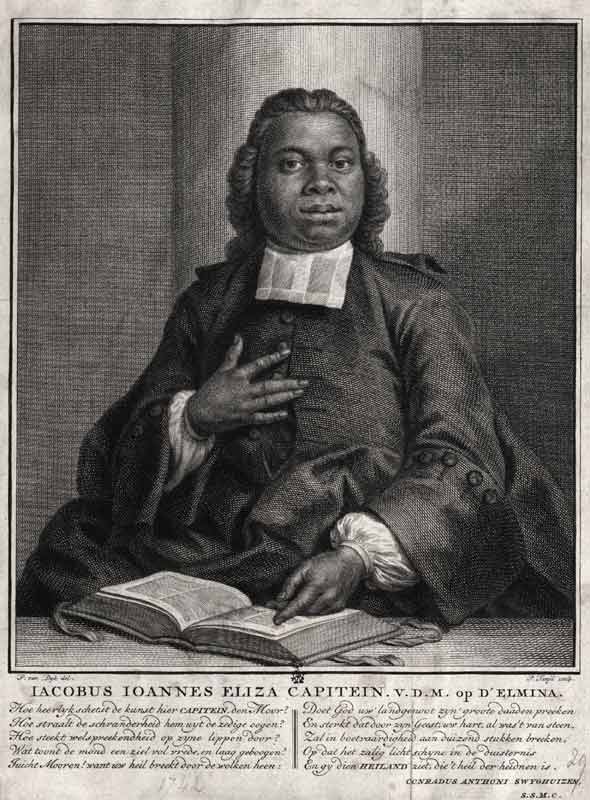Jacobus Capitein
 |
Picture from:
Van Dantzig, A, Het Nederlandse Aandeel in de Slawenhandel Fibula 1968 (in Dutch)
Credit: Rijkmuseum, Amsterdam
The caption reads:
Jacobus Elisa Joannes Capitein
Africaansche Moor
Beroepen Predikant aan het Kafteel st George op D'Elmina
Aanfehouwer sie dee z'MOOR! zijn vel is swart maar wit
zijn siel, daar JESUS self als Priester vor hem bidt
Hij gaat Geloof, en Hoop, en Liefde aan Mooren leren,
Op dat zij, witgemaakt, met hem het LAM steeds eeren
|
Bartels, F. L., Jacobus Eliza Capitein 1717-1747 Trans Hist Soc. of Ghana, 43-13 (1959),47 (quotations and notes)
Born 1717. At 7 or 8 sold to a ship's captain called Steenhardt. Took him to Middelburg in Zeeland, Holland. Later brought him back to Elmina Castle then to Shama. Steenhardt presented him to Jacobus van Goch, factor of the Dutch West India Company (DWIC) in Shama who gave him the name Capitein. Van Goch took him to Holland, arriving at the Hague in 1726. Capitein learnt Dutch and painting, reading, writing, cyphering and arithmetic, catechism, manners, customary prayers. Went to Latin school. Grounding in classics. At Leyden University on 10 March 1742 delivered an oration in Latin on the question `Is slavery contrary to Christian freedom or not?' Published in Latin and Dutch. Argued that though Christian love prevented Christians from treating their slaves with cruelty and allowed that after some time freedom might be allowed to the slave, there was no express command in the Gospel to that end, nor was slavery contrary to Christian freedom.
17 May 1742 ordained at Amsterdam. Sermons published. Appointed preacher and school master at Elmina by the church authorities at the request of the Directors of the DWIC. Arrived at St. George d'Elmina on 8 October, 1742 at age of 25.
7 No chaplain for previous 8 years. Previous chaplain Pastor Isaacus Ketelanus had been dismissed because of the bad life he had been leading. (1734) 241 Dutch on the Coast, 107 at Elmina. Director General (DG) Jacob de Pettersen welcomed Capitein. Liked his sermons. Gave him a large room for a schoolroom. Within 2 weeks of arrival Capitein had placed a number of black and mulatto boys, under supervision of Abraham Zuurdeeg, the Dutch reader in the castle. Learning the alphabet Feb 1743. 18-20 children being taught principles of Christianity. Most in service of Dutch castle staff. Two white children. Two little mulatto girls. Kids preferred to play on the beach to going to school.
8 Numbers small. April 1743 spoke to chiefs of Elmina of his mission. Enrolment rose to 45 including 4 mulatto boys, 7 mulatto girls, 5 negro girls.
9 Asantehene Opoku Ware sent 12 boys and 2 girls to the DG asking that they be sent to Holland to be taught reading, writing, music. 11 put in Capitein's school, in the charge of a woman called Coffiba. Jacje sent to Holland with ten elephant tusks to pay for the children's education. Children taught to read and spell. Tolerable understanding of the creed or 12 articles of belief, Lord's prayer, ten commandments. Lesson books and pictures sent out by the Directors. By October 1744: progress. Capitein proposed to send 2 or 3 to Holland for further instruction.
Translated 12 articles of belief, Lord's prayer, ten commandments into vernacular. Used it in his school.
DWIC had ten directors.
Capitein taught and supervised school, bible classes on Mondays in his room, instruction in the catechism on Thursdays, preaching on Sundays. In emoluments as well as position Capitein was next to the DG. DG 300 guilders a month, Capitein - 100 and rations. Rations for two weeks; 12 lb meat, 4 1/2 tins peas, 4 1/2 tins barley, 1 1/8 tins oil, 3/4 tin vinegar, 135 measures of herrings.
11 DG continued support but other officials were generally uncooperative. Among them was the officer Hubert van Rijk who spoke contemptuously of Capitein and his work in public. Capitein's position gradually became untenable. July 1745 asked Company to relieve him of his office. Request not granted. Began to take an interest in trade, selling his rations. Proposed to set up an orphanage or seminary to isolate day students from he town. Directors not interested. Wanted to marry an African girl, but there were problems. Her parents would not let her go to Holland for education. Classis (religious bosses) sent out Antonia Ginderlos of the Hague, whom he married. Incurred debts through trade. Died at 30 in 1747. Petersen supported the school until he retired in the same year. 8 DG's followed in the next 20 years. None very interested.
OTHER REFERENCES
Kpobi, David Nii Anum THE SAGA OF A SLAVE: Jacobus Capitein of Holland and Elmina vii, 102pp, GHANA. SUB-SAHARAN PUBLISHERS, 9988812108 2002 Paperback
Prah, Kwesi Kwaa, Jacobus Eliza Johannes Capitein, 1717-1747 : A Critical Study of an Eighteenth Century African, AFRICA WORLD PRESS INC.,1992
Wiltgen, R. M, Gold Coast Mission History 1471-1880 Techny Ill, 1956